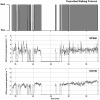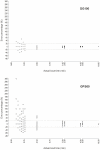The accuracy of a simple, low-cost GPS data logger/receiver to study outdoor human walking in view of health and clinical studies
- PMID: 21931593
- PMCID: PMC3172201
- DOI: 10.1371/journal.pone.0023027
The accuracy of a simple, low-cost GPS data logger/receiver to study outdoor human walking in view of health and clinical studies
Abstract
Introduction: Accurate and objective measurements of physical activity and lower-extremity function are important in health and disease monitoring, particularly given the current epidemic of chronic diseases and their related functional impairment.
Purpose: The aim of the present study was to determine the accuracy of a handy (lightweight, small, only one stop/start button) and low-cost (∼$75 with its external antenna) Global Positioning System (GPS) data logger/receiver (the DG100) as a tool to study outdoor human walking in perspective of health and clinical research studies. Methods. Healthy subjects performed two experiments that consisted of different prescribed outdoor walking protocols. Experiment 1. We studied the accuracy of the DG100 for detecting bouts of walking and resting. Experiment 2. We studied the accuracy of the DG100 for estimating distances and speeds of walking.
Results: Experiment 1. The performance in the detection of bouts, expressed as the percentage of walking and resting bouts that were correctly detected, was 92.4% [95% Confidence Interval: 90.6-94.3]. Experiment 2. The coefficients of variation [95% Confidence Interval] for the accuracy of estimating the distances and speeds of walking were low: 3.1% [2.9-3.3] and 2.8% [2.6-3.1], respectively.
Conclusion: The DG100 produces acceptable accuracy both in detecting bouts of walking and resting and in estimating distances and speeds of walking during the detected walking bouts. However, before we can confirm that the DG100 can be used to study walking with respect to health and clinical studies, the inter- and intra-DG100 variability should be studied.
Trial registration: ClinicalTrials.gov NCT00485147.
Conflict of interest statement
Figures


Similar articles
-
The inter- and intra-unit variability of a low-cost GPS data logger/receiver to study human outdoor walking in view of health and clinical studies.PLoS One. 2012;7(2):e31338. doi: 10.1371/journal.pone.0031338. Epub 2012 Feb 20. PLoS One. 2012. PMID: 22363623 Free PMC article. Clinical Trial.
-
Study of human outdoor walking with a low-cost GPS and simple spreadsheet analysis.Med Sci Sports Exerc. 2007 Sep;39(9):1570-8. doi: 10.1249/mss.0b013e3180cc20c7. Med Sci Sports Exerc. 2007. PMID: 17805090
-
Accuracy of a low-cost global positioning system receiver for estimating grade during outdoor walking.Physiol Meas. 2016 Oct;37(10):1741-1756. doi: 10.1088/0967-3334/37/10/1741. Epub 2016 Sep 21. Physiol Meas. 2016. PMID: 27653453
-
What are the perceptions of people living with dementia, family carers, professionals and other potential stakeholders to the use of global positioning systems to promote safer outdoor walking?: a qualitative literature review.Disabil Rehabil Assist Technol. 2021 Aug;16(6):614-623. doi: 10.1080/17483107.2019.1686074. Epub 2019 Nov 11. Disabil Rehabil Assist Technol. 2021. PMID: 31711328
-
Folic acid supplementation and malaria susceptibility and severity among people taking antifolate antimalarial drugs in endemic areas.Cochrane Database Syst Rev. 2022 Feb 1;2(2022):CD014217. doi: 10.1002/14651858.CD014217. Cochrane Database Syst Rev. 2022. PMID: 36321557 Free PMC article.
Cited by
-
The Relationship Between Objectively Measured Walking and Risk of Pedestrian-Motor Vehicle Collision.Am J Epidemiol. 2017 May 1;185(9):810-821. doi: 10.1093/aje/kwx020. Am J Epidemiol. 2017. PMID: 28338921 Free PMC article.
-
Applications of Space Technologies to Global Health: Scoping Review.J Med Internet Res. 2018 Jun 27;20(6):e230. doi: 10.2196/jmir.9458. J Med Internet Res. 2018. PMID: 29950289 Free PMC article.
-
Technologies That Assess the Location of Physical Activity and Sedentary Behavior: A Systematic Review.J Med Internet Res. 2015 Aug 5;17(8):e192. doi: 10.2196/jmir.4761. J Med Internet Res. 2015. PMID: 26245157 Free PMC article.
-
Measuring Outdoor Walking Capacities Using Global Positioning System in People with Multiple Sclerosis: Clinical and Methodological Insights from an Exploratory Study.Sensors (Basel). 2021 May 4;21(9):3189. doi: 10.3390/s21093189. Sensors (Basel). 2021. PMID: 34064381 Free PMC article.
-
The inter- and intra-unit variability of a low-cost GPS data logger/receiver to study human outdoor walking in view of health and clinical studies.PLoS One. 2012;7(2):e31338. doi: 10.1371/journal.pone.0031338. Epub 2012 Feb 20. PLoS One. 2012. PMID: 22363623 Free PMC article. Clinical Trial.
References
-
- Bouchard C, Blair SN, Haskell WL. Physical activity and health; In: Bouchard C, Blair SN, Haskell WL, editors. Champaign (Ill.): Human Kinetics; 2007. 409
-
- Hakim AA, Petrovitch H, Burchfiel CM, Ross GW, Rodriguez BL, et al. Effects of walking on mortality among nonsmoking retired men. N Engl J Med. 1998;338:94–99. - PubMed
-
- Lee IM, Rexrode KM, Cook NR, Manson JE, Buring JE. Physical activity and coronary heart disease in women: is “no pain, no gain” passe? Jama. 2001;285:1447–1454. - PubMed
-
- Manson JE, Greenland P, LaCroix AZ, Stefanick ML, Mouton CP, et al. Walking compared with vigorous exercise for the prevention of cardiovascular events in women. N Engl J Med. 2002;347:716–725. - PubMed
-
- Manson JE, Hu FB, Rich-Edwards JW, Colditz GA, Stampfer MJ, et al. A prospective study of walking as compared with vigorous exercise in the prevention of coronary heart disease in women. N Engl J Med. 1999;341:650–658. - PubMed
Publication types
MeSH terms
Associated data
LinkOut - more resources
Full Text Sources
Medical

